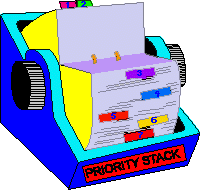| Proirities
|
|
|
|
|
 |
|
|  Defining Priority Defining Priority
|
|
Priority boils down to the amount
of pressure to get the job done. This pressure may be internal
(e.g., decisionmakers in Washington or elsewhere see this action
as an important plank in the overall program) or external (e.g.,
this action is driven by a court or congressional mandate).
Higher priorities command more attention, staff, and money at
a given time. Lower priorities aren't dropped completely, but
they have fewer allocated resources.
|
|
|
 |
|
|  Establishing Reclamation's Priority Establishing Reclamation's Priority
| 
|
| Determining what has priority is really
a matter of deciding what tradeoffs to make. to make.
|
| 
|
|
|
Priority starts at a local level by listing
community-based issues consistent
with Reclamation's mission. This list
provides a backdrop to determine which watershed issues and
regional needs are most pressing or important. Public involvement
efforts on projects, public affairs offices, and other internal
resources as well as news media and local organizations are
good sources of information. Reality
checks help to determine what is important. Issues are then
examined on an increasingly larger scale to determine priority
(local, regional, national). The Administration's (President's,
Secretary's, and Commissioner's) statements of public policy
and programs as well as the Congress' mandates to determine
the issues that are being emphasized (e.g., wetlands, water
conservation, waste water reuse, and water quality) reflect
this examination. Call letters and previous appropriations
will also point out priority work. and previous appropriations
will also point out priority work.
Priorities need to be determined:
|
|
|
|
|
| Priority stacks show which issues
take precedence. This could be a simple list or a bunch
of yellow stickies in order of priority. This stack will
keep everyone focused on the important items. show which issues
take precedence. This could be a simple list or a bunch
of yellow stickies in order of priority. This stack will
keep everyone focused on the important items.
|

|
|
|
|
 |
|
|  Juggling Priorities Juggling Priorities
| 
|
| Priorities are not set up to be executed
in lock-step fashion. Instead, various activities with
varying degrees of priority can
be accomplished by putting more energy and effort
into the higher prioirty items than the lower ones.
|
| 
|
|
|
Constraints on your
process may change the priority. An issue or program that may
burning at one point may be put on the back burner by the next
administration. Politics and agendas
change.
|
|
| |
You may have four number one priorities on
your desk--and your resources will be pultled in more directions.
Priorities may differ from one level of the organization to
another, and among organizations. This often requires negotiation
and clarification at higher levels. Realistically determine
what can be done and communicate with all involved parties The
more programs are aware of other priorities and limitations,
the more efficiently resources can be used. |
|
|
 |
|
|  Go On Go On
| 
|
| Remember that there will always be another
effort with a higher priority. |
| 
|
|
|
Executive
Summary Tour  Agendas <------>
Risk Agendas <------>
Risk |
|
| |
Dragon Tour
 Politics
<-------> Change Politics
<-------> Change |
|
| |

|
|